Facial lesions
Dr Mike Wyndham is a GP in a suburban practice in Edgware Middlesex
Dr Mike Wyndham is a GP in a suburban practice in Edgware Middlesex
He has always been a keen photographer, and has been taking medical photographs for more than 25 years. He has been a regular contributor to the GP press and his work has also appeared in the British Medical Journal, The Pharmaceutical Journal and various medical text books
Not surprisingly, dermatological conditions that affect patients' faces are particularly distressing, possibly because they are often difficult to conceal. They can lead to loss of confidence and social isolation, but most will respond to treatment. Practice nurses also need to be vigilant for early signs of potential malignancy in patients presenting with facial lesions
ERYSIPELAS
Erysipelas is an infection that affects the superficial layers of the skin. It is usually caused by streptococcal infection but staphylococci may the infecting organism. The nasopharynx is thought to be a reservoir for the infection. It is more likely to occur in those people who are diabetic, or have HIV disease. The patient may become systemically unwell with fever and rigors, which may precede the development of the rash. The affected skin becomes red and may be swollen. Treatment should be with anti-pyretics and phenoxymethylpenicillin. In those allergic to penicillin, a macrolide such as clarithromycin should be used.
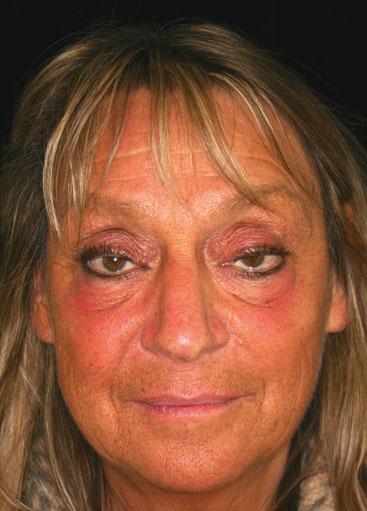
PHOTOSENSITIVITY REACTION
Photodermatoses may result from the direct impact of ultraviolet light on the skin as seen in polymorphic light eruption. Some genetic disorders, such as xeroderma pigmentosum, may predispose to the condition. Some conditions, including herpes simplex, are worsened by sunlight. Some prescription drugs may also be associated with a skin reaction. Most of these reactions would be classified as phototoxicty but some drugs cause a photoallergy. Amiodarone is associated with the development of a slate-grey appearance to the skin. This lady reacted to light exposure as she had been taking doxycycline. The clue to the diagnosis was that only the light-exposed areas of her skin were affected.

ROSACEA
Rosacea most commonly occurs between the age of 40-50 years and in people with fair skin. The onset of the condition may be predicted by the development of flushing and redness of the skin. Flushing may occur as a result of consuming hot drinks and spicy food. The rash may develop on the forehead, cheeks and chin, and consists of papules, pustules and telangiectases. The absence of comedones helps to differentiate from acne vulgaris. The nose may develop an excess of soft tissue, which is more common in men, and is called a rhinophyma. The eyes may become involved with the development of blepharitis and keratitis. Initial treatment should be topical with metronidazole gel or azelaic acid. If this fails to cure the problem then an oral tetracycline should be used.
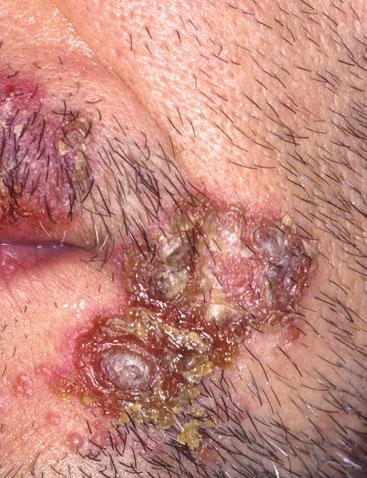
IMPETIGO
Impetigo occurs much less commonly these days. Children are mostly affected but not exclusively so, as in this picture. The causative organism is usually Staph. aureus but impetigo may also be caused by the Streptococcus bacterium. A golden colour would suggest Staph. aureus as the cause. The picture shows a vesicular eruption and it can be presumed that if these vesicles coalesce, bullae will form. Treatment is with flulcoxacillin providing the patient is not allergic. From previous experience, this may not be sufficient and I usually recommend application of topical fucidic acid. The Health Protection Agency recommends that children should be off school 'until lesions are crusted and healed, or 48 hours after commencing antibiotic treatment'.
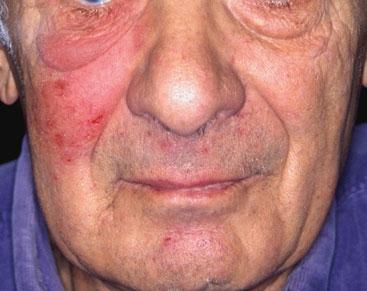
BASAL CELL CARCINOMA
Basal cell carcinomas (BCC) occur most commonly on the face. Sunlight may be an important causative factor but is probably not the only one. Some lesions predispose to development e.g. sebaceous naevus of the scalp (to be covered in a future article). BCCs may take on a variable appearance e.g. superficial or cystic. The lesion shown is nodular. It has a dome-shaped edge. However, as it has been present some time it has started to dip at the centre and has ulcerated on one of it's sides. There are pigmented edges present. There are a variety of treatments for BCCs including curettage, cryotherapy and excision.
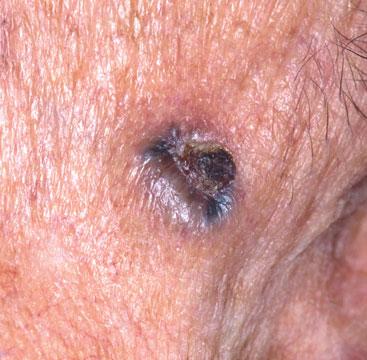
LUPUS PERNIO
Sarcoidosis is a multi-system disorder that affects, for example, the chest - hilar lymphadenopathy, or the eyes - anterior uveitis. It is more common in people of Africo-Caribbean, Scandinavian and Africo-American origin. When sarcoid affects the skin it may manifest in many ways, including plaques, nodules and papules. It may also cause erythema nodosum. One variety of skin problem is lupus pernio, where the disease affects the skin of the face and ears. It usually has a purplish appearance, may be lumpy and lead to tissue breakdown. Some patients are asymptomatic and the lesion on the nose of this lady was the first indication of the condition. As the sarcoidosis was considered to be inactive, the nose was treated with a potent topical steroid.
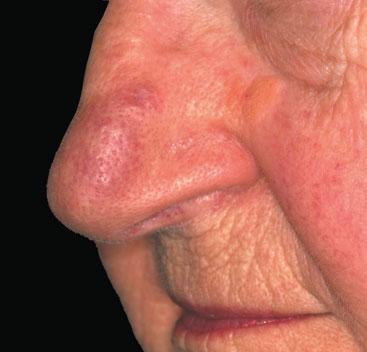
Related articles
View all Articles